Promotion (also one of
the 4P’s of marketing) which is known as marketing communication is one of the
major attribute for any of the product or services. For any brand one of the
major issues faced is that of sustaining its market share. They need to trade
off between maintain their brand in the market coupled with making acceptable
profits. To attract more customers and to increase their market share,
companies adopt various promotion techniques which help in generating revenue.
For this purpose there are 8 major modes of communication in marketing
communication mix as follows:
In addition to that it
is very important that we understand the concept of Above the Line (ATL) and
Below the Line (BTL) advertising and Through the line (TTL).
- Above
the Line (ATL) advertising is where mass media is used to promote
brands and reach out to the target consumers. These include conventional media
as we know it, television and radio advertising, print as well as
internet. This is communication that is targeted to a wider spread of
audience, and is not specific to individual consumers. ATL advertising tries to
reach out to the mass as consumer audience.
- Below
the line (BTL) advertising is more one to one, and involves the
distribution of pamphlets, handbills, stickers, promotions, brochures placed at
point of sale, on the roads through banners and placards. It could also involve
product demos and samplings at busy places like malls and market places or
residential complexes. For certain markets, like rural markets where the reach
of mass media like print or television is limited, BTL marketing with direct
consumer outreach programmes do make the most sense.
- Through
the line (TTL): “Through-the-line” marketing is the combination of
above-the-line and a specific type of below-the-line activity that is direct
marketing. The essence of “through-the-line” marketing is to use mass
advertising for forming a prospects / customers database which can be used for
direct marketing activities e.g. an ad in a magazine in which a toll-free
number is displayed that is used for direct contact with prospects.
MAGNUM uses all these
kinds of advertising extensively. A pictorial representation of these concepts
is given as follows:











.jpg)



